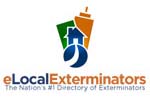Bees, Yellow Jackets, & Wasps
Flying Insects Pest Control
Bees, Yellow Jackets, & Wasps
Information About Bees, Yellow Jackets, & Wasps
Social wasps have the typical “wasp” body type; a very distinct head with chewing mouthparts, short-elbowed antennae, and large compound eyes. The thorax and abdomen are brightly marked with yellow, red, or brown on a black background. The wasps have four clear or smoky brown wings. They have a short, narrow attachment between the thorax and the abdomen. The abdomen is spindle-shaped and tipped with a long stringer.
Yellow jackets are usually marked with bright yellow and black patterns, appear hairless, and are about 3/8 to 5/8 inches long. The boldfaced hornet is similar in appearance except that it is white and black and 5/8 to 3/4 inches long./
The giant European hornet is 3/4 to 1 3/8 inches long and brown and yellow. Paper wasps can be distinguished from yellow jackets and hornets because their abdomen is tapered at the tip and at the point where it joins the thorax. They are sometimes marked with yellow, brown, or red patterns on black and are 5/8 to 3/4 inches long.
Biology
Social wasps have large nests containing three types of individuals, or castes; queens, workers, and males. The males and queens are produced in the colony in late summer. They mate, and the fertilized queen overwinters in a protected site. In spring, she seeks an appropriate nesting site in which she builds a paper nest using chewed up wood fibers. Eggs are laid in the cells of the nest, and the young larvae are fed bits of chewed up meat or insect parts by the queen and later by the workers.
Habits
Yellow jackets and hornets build their flat paper nests in stacks which are surrounded by a paper envelope. Yellow jackets usually build their nests below ground and in other protected locations. Baldfaced hornets prefer to build their nests in trees and on the sides of buildings. European hornets build their nests inside hollow trees, wall voids, and underground. Paper wasps build open flat nests, without a paper envelope, usually found under the eaves of a house and in other protected locations. Social wasps use their nests only one season.
Unlike bees, these wasps aggressivly defend their nests and can inflict multiple stings. They produce very large colonies with some yellow jacket nests containing as many as 30,000 individuals. These insects are considered to be beneficial because they feed their young a wide variety of insects. They become a nuisance, however, when they build nests in or near structures; scavenge for food in recreational areas and in other places frequented by humans; and seek overwintering sites in structures.



